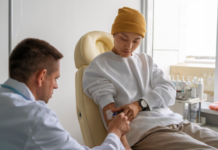A stroke, often referred to as a “brain attack,” occurs when blood flow to the brain is interrupted, leading to damage to brain cells. It’s a life-altering event that can cause physical, cognitive, and emotional challenges for individuals. However, stroke rehabilitation offers hope and the opportunity for rebuilding lives. In this article, we’ll delve into the journey of stroke rehabilitation, exploring the stages, challenges, triumphs, and innovative approaches that pave the path to recovery.
Understanding Stroke Rehabilitation
Stroke rehabilitation is a comprehensive process aimed at helping individuals regain independence and improve their quality of life after a stroke. It encompasses various therapies and interventions designed to address the physical, cognitive, and emotional effects of stroke. The primary goals of stroke rehabilitation are to restore lost abilities, prevent complications, and promote long-term recovery. It’s a collaborative effort involving healthcare professionals, stroke survivors, and their families.
Early Stage Rehabilitation: Immediate Post-Stroke Care
In the immediate aftermath of a stroke, individuals receive acute care in hospitals. Here, the focus is on stabilizing vital functions and preventing further damage. Physical therapists, occupational therapists, and speech therapists play crucial roles in providing early rehabilitation interventions. They work closely with stroke survivors to initiate movement, improve motor function, and address communication and swallowing difficulties. The goal is to lay the foundation for recovery and minimize disability.
Intermediate Stage Rehabilitation: Inpatient Rehabilitation Facilities
As individuals stabilize medically, they may transition to inpatient rehabilitation facilities for intensive therapy and support. These facilities offer multidisciplinary rehabilitation programs tailored to the needs of stroke survivors. Therapists guide individuals through daily therapy sessions focused on mobility, activities of daily living, and cognitive skills. Rehabilitation teams collaborate closely, incorporating feedback from stroke survivors and adjusting treatment plans as needed. The emphasis is on maximizing functional independence and preparing individuals for the transition home.
Long-Term Rehabilitation: Outpatient Services and Home Care
Upon discharge from inpatient rehabilitation, stroke survivors continue their recovery journey through outpatient services and home care. Outpatient therapy sessions provide ongoing support and reinforcement of skills learned during inpatient rehabilitation. Additionally, home-based therapy and caregiver support are essential components of long-term rehabilitation. Therapists help individuals adapt to their home environments, implement strategies for independent living, and address any ongoing challenges. The goal is to facilitate a smooth transition back to community life while promoting continued progress and recovery.
Challenges and Triumphs: Personal Stories of Stroke Survivors
Behind every stroke rehabilitation journey are stories of resilience, perseverance, and triumph. Stroke survivors face numerous challenges along the way, from physical limitations to emotional struggles. However, they also experience moments of triumph as they achieve milestones and regain lost abilities. Personal stories of stroke survivors serve as powerful reminders of the human spirit’s resilience and the transformative power of rehabilitation. These stories inspire hope and encourage others facing similar challenges to persevere on their journey to recovery.
Innovative Approaches to Stroke Rehabilitation
Advancements in technology and research have led to innovative approaches to stroke rehabilitation. Robotics, virtual reality, and neurostimulation are revolutionizing rehabilitation by offering new avenues for therapy and recovery. These technologies provide interactive and engaging rehabilitation experiences, allowing stroke survivors to practice movements, improve motor function, and relearn skills in a virtual environment. Additionally, emerging therapies such as constraint-induced movement therapy and mirror therapy show promise in enhancing motor recovery and promoting neuroplasticity.
Conclusion
Stroke rehabilitation is a journey of hope, healing, and transformation. Through comprehensive rehabilitation programs and innovative interventions, individuals affected by stroke can rebuild their lives and reclaim their independence. At SennoGroup, we’re committed to supporting stroke survivors on their rehabilitation journey. Our dedicated team of healthcare professionals provides personalized care and evidence-based interventions to help individuals achieve their rehabilitation goals. If you or a loved one has experienced a stroke, know that you’re not alone. With the right support and resources, recovery is possible, and a fulfilling life awaits beyond stroke rehabilitation.\




